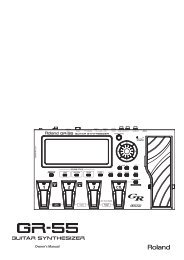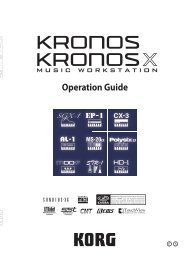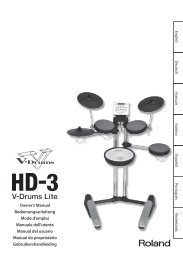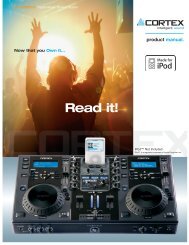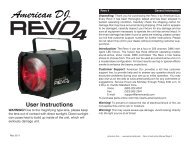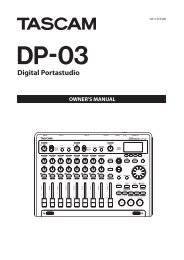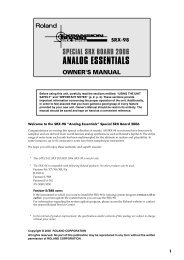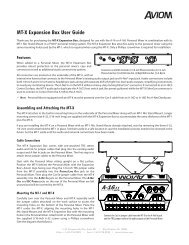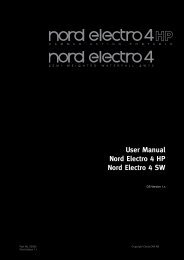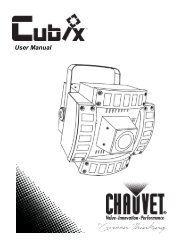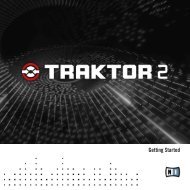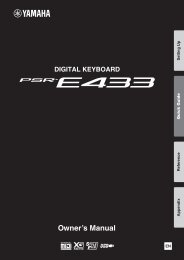Korg Microkorg Owner's Manual - zZounds.com
Korg Microkorg Owner's Manual - zZounds.com
Korg Microkorg Owner's Manual - zZounds.com
You also want an ePaper? Increase the reach of your titles
YUMPU automatically turns print PDFs into web optimized ePapers that Google loves.
Editing a synth program<br />
○ ○ ○ ○ ○ ○ ○ ○ ○ ○ ○ ○ ○ ○ ○ ○ ○ ○ ○ ○ ○ ○ ○ ○ ○ ○ ○ ○ ○ ○ ○ ○ ○ ○ ○ ○ ○<br />
○<br />
Overview<br />
The three attributes of sound: pitch, tone, and volume<br />
Sound has three basic attributes; pitch, tone, and volume.<br />
To control these attributes, the microKORG analog modeling synthesizer provides<br />
"oscillator," "filter," and "amp (amplifier)" sections, just as on the analog synthesizers<br />
of the past.<br />
The "oscillator" settings vary the pitch, the "filter" settings modify the tone, and the<br />
"amp" settings modify the volume.<br />
The microKORG's "oscillator," "filter," and "amp"<br />
On the microKORG, the OSC1, OSC2, and PITCH sections control the "oscillator".<br />
The PITCH section specifies the pitch of the waveform that is the basis of the<br />
sound, and the OSC1 and OSC2 sections select the waveforms. The waveforms<br />
generated here are mixed by the MIXER section.<br />
The microKORG's FILTER section modifies the tone. Then the AMP section<br />
modifies the volume and outputs the final sound.<br />
These three sections determine the basic sound of the program.<br />
EG, LFO, keyboard tracking, virtual patch, controllers<br />
In addition to the sections described above, the microKORG provides ways in<br />
which the sound can be varied according to time, key range, or various types of<br />
performance expression. These are controlled by modulators and controllers such<br />
as EG (envelope generator), LFO (Low Frequency Oscillator), keyboard tracking,<br />
Virtual Patch, and the PITCH and MOD wheels. You can use these modulators and<br />
controllers to apply change to the basic sound of the program.<br />
Figure 0-1 (at right) shows the structure of a synthesizer sound on the microKORG.<br />
Look at TIMBRE 1, and notice how the signal flows in the order of OSC ➝ FILTER<br />
➝ AMP. Also notice how modulators such as EG and LFO can affect these blocks.<br />
The structure of a synth program<br />
As shown in figure 0-1, a synth program consists of timbres 1/2, effects, and the<br />
arpeggiator.<br />
TIMBRE 1/2<br />
Each timbre consists of OSC, FILTER, AMP, EG, LFO, and Virtual Patch blocks. You<br />
can create more <strong>com</strong>plex programs by using two timbres together in one program<br />
using the Layer feature.<br />
EFFECTS<br />
The output of timbres 1/2 is sent to the modulation effect (MOD FX) ➝ delay effect<br />
(DELAY) ➝ equalizer (EQ).<br />
For the modulation effect you can choose from three types of effect such as chorus.<br />
For the delay, you can choose from three types of delay such as stereo delay. The EQ<br />
is a two-band equalizer.<br />
ARPEGGIATOR<br />
You can apply the arpeggiator to a timbre. If the program uses two timbres, you can<br />
apply the arpeggiator to either or both timbres. This is a step arpeggiator with six<br />
arpeggio types.<br />
Figure 0-1<br />
(in the case of Layer)<br />
Free Assign<br />
KBD Track<br />
Velocity<br />
Mod. wheel<br />
Pitch bend<br />
15



